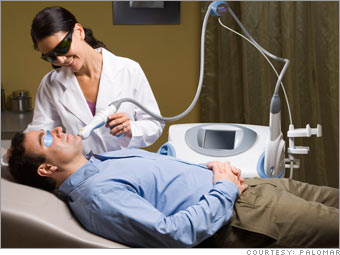I met Clint over at a local pub in Park City and we sat down to chat about Thermage and Surface. (Clint didn't know about this blog.)
Clint is a fairly recent addition to Thermage's management team as the Vice President of Domestic Sales. Most recently, he came from the company Bausch & Lomb, where he oversaw the turn-around of a 25M division of B&L. He has also worked for Johnson & Johnson and has a long resume of larger companies. Clint seems to be a really nice guy. I liked him tremendously and I thought he really understood the marketplace and what was taking place.
I have had problems with Thermage in the past, mostly having to do with the way that I think they were selling their devices to physicians. Over our pizzas, Clint and I talked about a number of problems that I think Thermage is facing and what's happening to the market and physicians. His answers were educational, not in the least defensive, and straight forward.
Themage has been saddled with a number of problems in the past; technician error, physician education, efficacy, pain, expense, and other issues have combined to cause a recession in what was initially a promising growth curve for the adaptation of radio frequency skin tightening. In my opinion, most of this had to do with the way that Themage sales reps were presenting the device to physicians as a fire-and-forget type of technology that you could have a technician performing in the back room while you saw other patients. No physician oversight led to a vicious cycle where, since the treatment was painful, technicians would continually turn down the treatment in order to get the patient through, the patient wouldn't see any results and would complain to the physician, and then the physician would get pissed off. This cycle has ended up leading to declining Themage sales and devastating impact to Thermage's reputation among physicians.
Starting in about September 2005, Thermage has experienced a rebirth of sorts, in part because of a new management team and sales force. They've introduced bigger treatment tips (effectively reducing the price per area) and they have a number of new areas including eyelids and body treatments. They're bringing out a number of additional tips that will go deeper into the dermis to treat cellulite, as well as some specifically for fine lines around the eyes.
This has resulted in Thermage actually starting to experience growth in sales again, which is both good for them and treated patients. They have retrained their sales force and are looking to not only offer additional treatment tips for their device, but potentially expand their offering. The end game of course is that Thermage expects to become a publicly traded company in the future. (Clint and I spoke about this, but since I'm unsure what he may consider confidential I won't go into details.)
Thermage is also supporting the top Thermage providers significantly better than they have in the past. Two years ago providers were treated exactly the same whether they provided one Thermage treatment a year or 1000. As a business, Thermage has decided that the top providers are both more lucrative as a business as well as potentially more beneficial to the patient since Thermage is one of those treatments that is very treatment dependent. It is not a push button technology and results can very dramatically depending upon the treatment levels and number of hits.
(One of the gems that Clint dropped was that they are not focusing more and more of their marketing efforts on those physicians who are actually performing Thermage and expect that other physicians in the market place will look to those leaders and as they become mass market adaptors of this technology.)
In discussing the medical spa market that exists now, Clint was pretty much in agreement with me about the state of the market including medical spa consultants and franchises.
Interestingly, when the discussion turned to plastic surgeons and dermatologists, Thermage (which had been focused almost exclusively on these two specialities in the past), is becoming more and more open to what Clint described as "Blue Collar Doctors" who are physicians that are treating hundreds or thousands of patients a year that might potential be outside of cosmetic medicine as a speciality.
It'll be interesting to see how the plastic surgeons and dermatologists respond to this since there was discussion also about the recent laws passed in Florida preventing non plastic surgeons or derms from overseeing outside clinics.
I talked to Clint a fair amount of time about what their competitors were doing, including Cutera's Titan, Palomar's new Fraxel like head and a number of others, and asked him specifically as to whether or not Thermage was worried that some of the technologies were being developed could potentially cause Thermage problems. Clint responded that he expected some good technology development out of all of these competitors and I was pleasantly surprised to see that he didn't take the opportunity to bad mouth any of them, but he felt that Thermage was still the "gold standard". Our own physicians tend to agree with that statement.
But Thermage faces significant hurdles Fraxel, Cutera's Titan IR head, Palomars Fraxel-like head, and a number of other technologies that are being developed and are getting better. Thermage is going to have to become more than a one trick pony in order to survive as the market consolidates and Clint expressed that was indeed their understanding as well. It will be interesting to see if Thermage is able to execute over the next 24 months.
I was impressed with Clint and if he's representative of Thermage's new look I think it bodes well for Thermage.





















